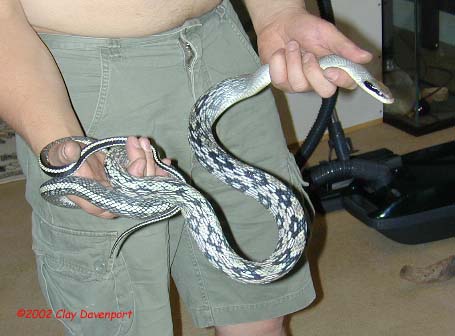



The ratsnakes of southeast Asia are my favorites of all colubrids. It is a very large group of snakes and contains great variety in physical appearance, temperment, and behavior.
Some are small, while others rank as the largest of all colubrids reaching as much as 10 feet. Some are docile, while others are quite agressive. I tend to prefer the latter as I do enjoy a snake with attitude.
Several of the species of this group are definitely not for beginners, being either highly agressive or requiring more difficult captive care requirements.
In 2002 I made the very difficult decision to sell me asian ratsnakes. I found myself in a bit of a caging crises and the large cages I needed for the species I kept at the time could not be utilized.
A couple of years ago I finally managed to begin venturing into the group once again with a trio of 100 flower ratsnakes (Orthriophis moellendorffi). I have yet to get pictures taken of this group however.
Below are some pictures of a few of the asians I have kept in the past.
I enjoyed keeping and breeding taiwan beauties for several years. They are one of the larger species, mine were fully grown at 8 feet long within 4 years. They have very large appetites, but their apparently high metabolism kept them from getting fat. They always got any extra rats that were left over during feeding times.
They were also very docile, even the hatchlings were reluctant to bite. Breeding was quite straightforward and clutches usually numbered from 12 to 20 large eggs.
Interestingly I noted that females would remain with their clutch after laying, coiled around them as pythons do. No ability to regulate clutch temerature was noted however.
I decided to test them one year and not remove the eggs immediately from the cage. The female remained coiled around them, leaving to drink and returning, for nearly two weeks. At this point the eggs were beginning to suffer from low humidity, as I was having a hard time keeping the moisture high in the laying box, so I removed them for artificial incubation. I do believe she would have stayed with them until hatching if I could have provided the proper conditions for the eggs.
From the species I've kept, I would highly recommend the Taiwans to anyone looking to venture into the keeping of the asian ratsnake group.


I maintained 1.2 blue beauties for several years and found them to be very similar to the taiwans. Mine were quite docile, but would bite on occasion if they perceived the need. I have heard reports of some individuals being quite agressive though, so perhaps I was luckier.
A blue beauty did however grant me my first bite to the face. I had a 5 foot female around my neck while I worked at getting a bit of stuck shed off her tail. She grew tired of that after a few minutes and let her irritation be known by biting me on the cheek about a half inch below my eye.
Their care is virtually identical to their Taiwan cousins, with the exception that they need higher humidity, particularly during shedding. Breeding was a simple affair with clutches numbering from 8 to 16 in my collection.




I found the radiated rats to be one of the most interesting species I've worked with. The female pictured below, nicknamed SOS, short for Spawn of Satan, was the most violent snake I've ever kept. She would deliver a continuous flurry of strikes to avoid being picked up, then once held would rotate between trying to get away and biting your hands and arms.
Inside her cage though she displayed a degree of intelligence and a keen awareness of her surroundings rarely seen in other species. She always watched closely when I was in the snake room, usually hiding behind a log monitoring my every move. Even from 20 feet away, if I looked directly at her she would slip back behind the log and peer back over it a few minutes later when she saw I was looking elsewhere.
The defensive display is quite interesting to observe. The front third of the body is raised and the neck is vertically flattened and drawn into a tight "S". The mouth is held open in the threat posture, and the snake will lunge forward striking repeatedly.
Unfortunately I never got a chance to reproduce this species. The female below was purchased as a pair and the male managed to escape when he was still a hatchling and I never replaced him.





